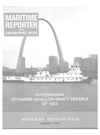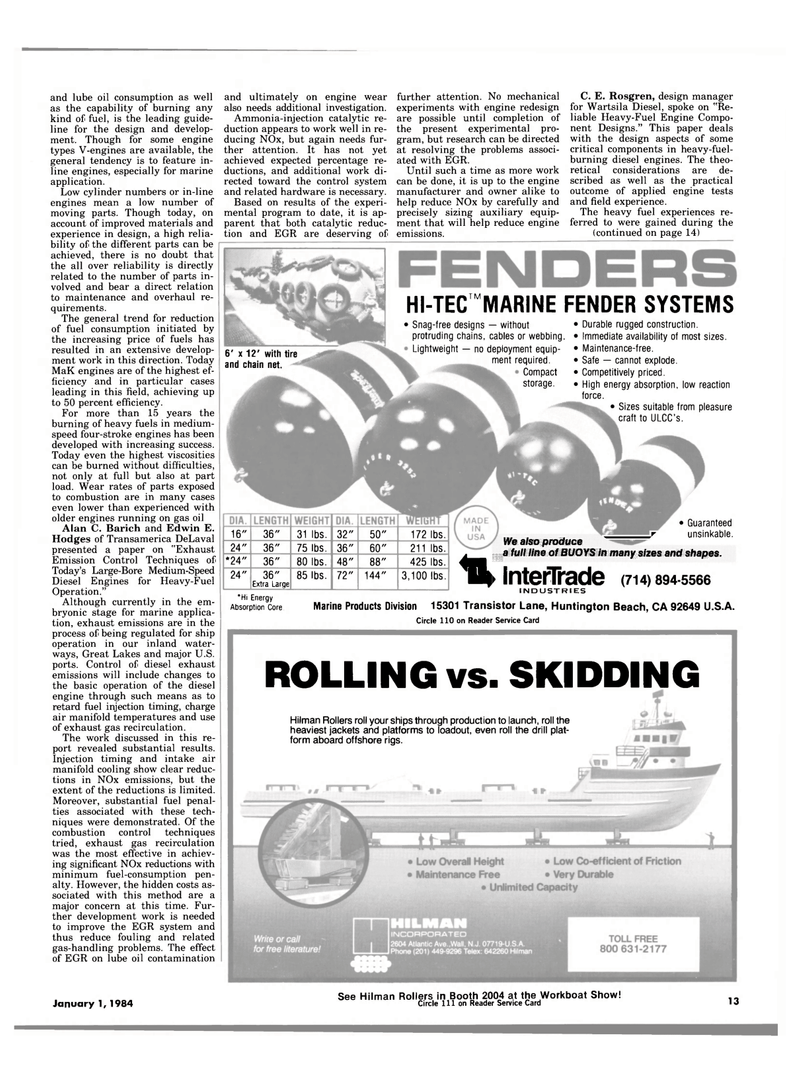
Page 11: of Maritime Reporter Magazine (January 1984)
Read this page in Pdf, Flash or Html5 edition of January 1984 Maritime Reporter Magazine
and lube oil consumption as well as the capability of burning any kind of fuel, is the leading guide- line for the design and develop- ment. Though for some engine types V-engines are available, the general tendency is to feature in- line engines, especially for marine application.
Low cylinder numbers or in-line engines mean a low number of moving parts. Though today, on account of improved materials and experience in design, a high relia- bility of the different parts can be achieved, there is no doubt that the all over reliability is directly related to the number of parts in- volved and bear a direct relation to maintenance and overhaul re- quirements.
The general trend for reduction of fuel consumption initiated by the increasing price of fuels has resulted in an extensive develop- ment work in this direction. Today
MaK engines are of the highest ef- ficiency and in particular cases leading in this field, achieving up to 50 percent efficiency.
For more than 15 years the burning of heavy fuels in medium- speed four-stroke engines has been developed with increasing success.
Today even the highest viscosities can be burned without difficulties, not only at full but also at part load. Wear rates of parts exposed to combustion are in many cases even lower than experienced with older engines running on gas oil
Alan C. Barich and Edwin E.
Hodges of Transamerica DeLaval presented a paper on "Exhaust
Emission Control Techniques of
Today's Large-Bore Medium-Speed
Diesel Engines for Heavy-Fuel
Operation."
Although currently in the em- bryonic stage for marine applica- tion, exhaust emissions are in the process of being regulated for ship operation in our inland water- ways, Great Lakes and major U.S. ports. Control of diesel exhaust emissions will include changes to the basic operation of the diesel engine through such means as to retard fuel injection timing, charge air manifold temperatures and use of exhaust gas recirculation.
The work discussed in this re- port revealed substantial results.
Injection timing and intake air manifold cooling show clear reduc- tions in NOx emissions, but the extent of the reductions is limited.
Moreover, substantial fuel penal- ties associated with these tech- niques were demonstrated. Of the combustion control techniques tried, exhaust gas recirculation was the most effective in achiev- ing significant NOx reductions with minimum fuel-consumption pen- alty. However, the hidden costs as- sociated with this method are a major concern at this time. Fur- ther development work is needed to improve the EGR system and thus reduce fouling and related gas-handling problems. The effect of EGR on lube oil contamination and ultimately on engine wear also needs additional investigation.
Ammonia-injection catalytic re- duction appears to work well in re- ducing NOx, but again needs fur- ther attention. It has not yet achieved expected percentage re- ductions, and additional work di- rected toward the control system and related hardware is necessary.
Based on results of the experi- mental program to date, it is ap- parent that both catalytic reduc- tion and EGR are deserving of further attention. No mechanical experiments with engine redesign are possible until completion of the present experimental pro- gram, but research can be directed at resolving the problems associ- ated with EGR.
Until such a time as more work can be done, it is up to the engine manufacturer and owner alike to help reduce NOx by carefully and precisely sizing auxiliary equip- ment that will help reduce engine emissions.
C. E. Rosgren, design manager for Wartsila Diesel, spoke on "Re- liable Heavy-Fuel Engine Compo- nent Designs." This paper deals with the design aspects of some critical components in heavy-fuel- burning diesel engines. The theo- retical considerations are de- scribed as well as the practical outcome of applied engine tests and field experience.
The heavy fuel experiences re- ferred to were gained during the (continued on page 14)
HI-TEC "MARINE FENDER SYSTEMS 6' x 12' with tire and chain net. • Snag-free designs — without protruding chains, cables or webbing.
Lightweight — no deployment equip- ment required.
Compact storage. • Durable rugged construction. • Immediate availability of most sizes. • Maintenance-free. • Safe — cannot explode. • Competitively priced. • High energy absorption, low reaction force. • Sizes suitable from pleasure craft to ULCC's. 16" 36" 31 lbs. 32" 50" 172 lbs. 24" 36" 75 lbs. 36" 60" 211 lbs. *24" 36" 80 lbs. 48" 88" 425 lbs. 24" 36"
Extra Large 85 lbs. 72" 144" 3,100 lbs. • Guaranteed unsinkable. We also produce a full line of BUOYS in many sizes and shapes. % interTrade *Hi Energy
Absorption Core
INDUSTRIES (714) 894-5566
Marine Products Division 15301 Transistor Lane, Huntington Beach, CA 92649 U.S.A.
Circle 110 on Reader Service Card
ROLLING vs. SKIDDING
Hilman Rollers roll your ships through production to launch, roll the heaviest jackets and platforms to loadout, even roll the drill plat- form aboard offshore rigs.
January 1,1984 See Hilman Rollers in Booth 2004 at the Workboat Show! Circle 111 on Reader Service Card 13

 10
10

 12
12
